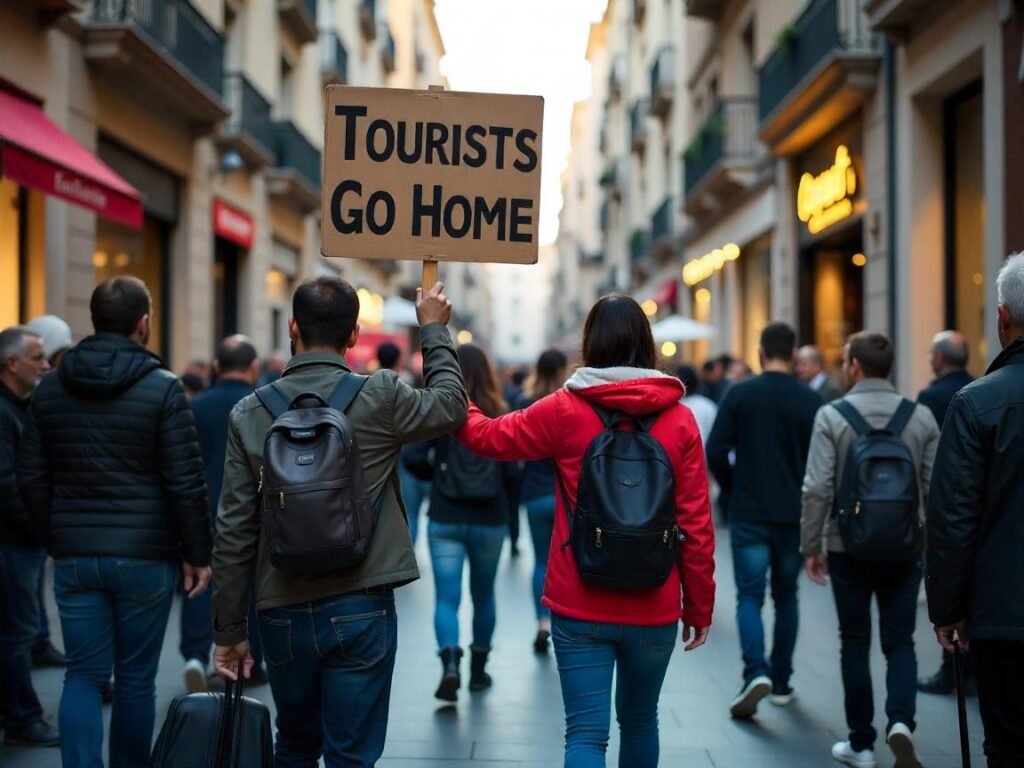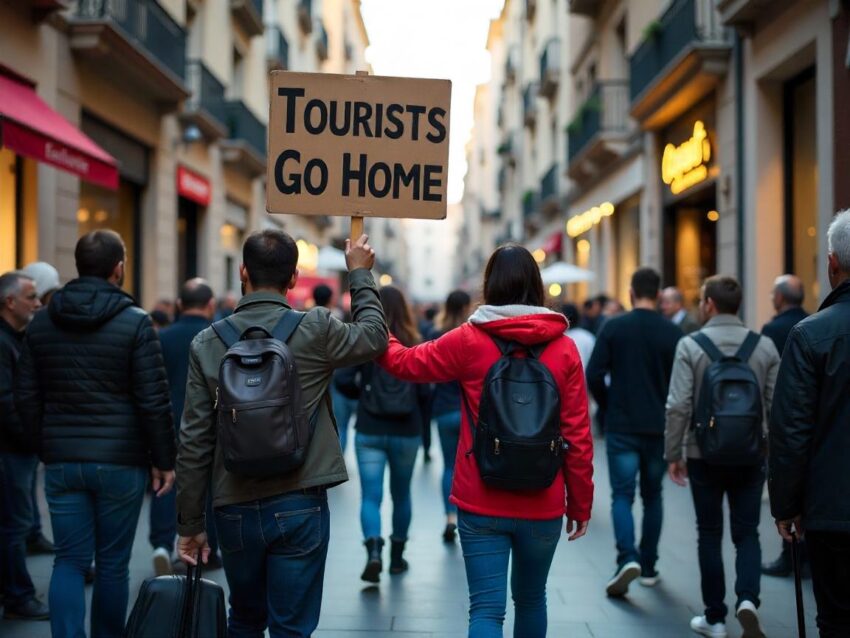
Tuesday, June 17, 2025

Overtourism is turning Europe into a minefield—socially, economically, and environmentally. Now, Spain, Italy, and Portugal have reached a dangerous boiling point. The very destinations that once rolled out red carpets for global travelers are now seeing red. Streets once filled with music and markets are now echoing with protest chants. And behind it all? The unstoppable rise of cheap airlines, budget stays, and mass travel surging in from the US, UK, Canada, Netherlands, France, and Germany.
Tourism has become a double-edged sword. While it fuels economies, it’s also draining local life. Spain, Italy, and Portugal are no longer just holiday dreams—they’re battlegrounds. Overtourism isn’t creeping in anymore. It’s crashing down.
Meanwhile, the tools that made travel so accessible—low-cost carriers, Airbnb-style rentals, discounted tours—are pushing local infrastructure to the brink. Mass travel doesn’t just fill hotels. It fills hospitals, roads, schools, and housing markets—with growing consequences.
Overtourism is no longer just a buzzword in policy rooms. It’s a living, breathing crisis playing out in real time. Protests are intensifying. Cities are cracking down. And residents are demanding change before it’s too late.
So what pushed Spain, Italy, and Portugal over the edge? Why are tourists from the US, UK, Canada, Netherlands, France, and Germany suddenly caught in a whirlwind of backlash?
This is the breaking point. This is the tourism story of the year. And what happens next could rewrite the rules of global travel forever.
Overtourism Boils Over: Why Europe’s Most Popular Destinations Are Now Battlegrounds for Survival
For three years, Europe’s most iconic cities have braced under the pressure of a growing, unchecked tourism surge. Now, the pressure has exploded. From the crowded alleys of Barcelona to the cliffside paths of Santorini, widespread protests have erupted with the force of a volcano—loud, disruptive, and impossible to ignore.
Overtourism is no longer just a buzzword. It’s a full-blown crisis.
From Welcome Mats to Water Pistols
This past weekend, cities across Spain, Italy, and Portugal witnessed powerful anti-tourism protests. Local residents, fed up with crowded streets and soaring rents, took to the streets armed not with slogans alone, but with water pistols and rolling suitcases—symbolic and disruptive.
In Barcelona, demonstrators marched down the city’s posh Golden Mile, soaking passing tourists with water while holding signs that read “Tourists go home” and “Tourism is stealing from us.”
These acts aren’t random. They’re calculated expressions of deep frustration. They’re symbolic of a fight for survival in cities that are being hollowed out by the very industry that once sustained them.
The Core of the Crisis: Housing and the Airbnb Effect
Behind the colorful chaos lies a serious issue—housing.
Locals across southern Europe are being pushed out of their own cities as short-term rentals skyrocket. Airbnb and similar platforms have come under intense fire for turning residential neighborhoods into de facto hotel zones.
The result? Locals can’t compete. Rent is no longer affordable. Communities are fractured. And resentment has turned to revolt.
Though Airbnb defends its role, pointing to the 63% of overnight visitors who still stay in hotels, the fact remains—traveler nights in short-term rentals rose by 57 million in 2024 alone, reaching 715 million. In comparison, hotels saw a 73 million night increase, totaling 1.9 billion. But the impact of short-term lets is disproportionate, saturating city centers and upending local economies.
Post-Pandemic Boom Becomes an Urban Headache
The end of lockdowns unleashed an unprecedented wave of revenge travel. Tourists flooded back into places like Barcelona, Athens, Lisbon, Venice, and Rome, eager to make up for lost time.
But local infrastructure wasn’t ready. Nor were local residents. Streets meant for locals became congested with foot traffic, bikes, Segways, and suitcases. Everyday life got swallowed by tourism.
For cities like Barcelona, where tourism contributes over 12% of national GDP, the balance has tipped too far. Now, the very engine of economic prosperity is also driving social unrest.
Europe Responds with Crackdowns and Caps
Governments are no longer standing on the sidelines.
- Barcelona has announced a full ban on Airbnb rentals by 2028.
- The Spanish government recently ordered Airbnb to remove nearly 66,000 listings from its platform.
- Santorini, Venice, and Bruges have implemented visitor caps and tourism taxes.
- Pompeii will now limit daily entries to 20,000 people.
- Even Ibiza is restricting cruise ship arrivals, once a golden goose of island tourism.
These are not isolated policy tweaks. They represent a paradigm shift in how European cities manage the flood of global travelers. The message is clear: quality over quantity.
Tourists Face a New Reality: Higher Costs, Stricter Limits
Travelers will soon feel the difference.
Expect higher prices, more restrictions, and fewer available rentals. Mass tourism is becoming more regulated, more localized, and more expensive. This shift may disappoint some visitors, but it’s a necessary evolution. The cost of cheap travel has been high—environmentally, socially, and economically.
And the long-term sustainability of the industry depends on valuing people over profits.
The Emotional Toll: Locals Want Their Cities Back
The protests sweeping southern Europe aren’t just about policy—they’re emotional cries from communities that feel erased.
When locals can no longer afford their rent, access their parks, or find peace in their own streets, tourism stops being a celebration of culture and becomes an invasion.
The emotional cost is immeasurable. Lifelong residents now face daily displacement, not from war or disaster, but from commercial tourism.
In 2025, Europe’s golden trio—Spain, Italy, and Portugal—are once again dominating the global travel map. These Mediterranean powerhouses are attracting tens of millions of visitors from across the world, with new travel dynamics emerging from both post-pandemic demand and growing market accessibility.
Behind the sun-drenched beaches and charming historic cities lies a more complex story. Tourism is booming, but the sources of that boom tell us how dramatically travel has changed—and where it’s headed next.
Let’s take a closer look at where the tourists are coming from and why these countries continue to top every traveler’s bucket list.
Spain: Still the King of European Tourism
Spain remains one of the most visited countries on the planet—and 2025 has only strengthened that claim.
Topping the charts is the United Kingdom, with approximately 18.4 million British tourists making their way to Spanish shores. That’s nearly 20% of Spain’s total arrivals. Cheap flights, cultural familiarity, and the promise of reliable sunshine keep British tourists loyal to destinations like the Costa del Sol, Canary Islands, and Barcelona.
Germany follows with 13 million visitors, while France comes in close at 11.9 million. These neighboring countries continue to make Spain their go-to destination for weekend breaks, summer holidays, and cultural retreats.
Meanwhile, the United States is gaining traction as a long-haul source, bolstered by strong air connections and the growing appeal of Spanish wine regions, heritage cities, and culinary experiences. Other significant contributors include Italy, Netherlands, Ireland, Sweden, and Switzerland.
Notably, China is emerging fast. With a projected 36% increase in Chinese arrivals during the summer of 2025, Spain is positioning itself to tap into Asia’s outbound tourism revival in a big way.
Italy: Art, Heritage, and a Steady Flow of Tourists
Italy continues to enchant travelers from all over the world, holding firm as a top-tier European destination.
Germany remains the top market, with 1.2 million German arrivals by mid-2025 alone. German tourists tend to favor northern Italian regions like Trentino, Veneto, and South Tyrol, known for blending Alpine charm with Italian flavor.
France and the United Kingdom also contribute millions to Italy’s visitor numbers. From romantic getaways in Venice to family holidays on the Amalfi Coast, the country’s timeless appeal spans generations and continents.
The United States ranks among the top five, showing the enduring allure of Italy for American travelers. From Rome to Florence to Sicily, Americans seek immersive cultural experiences, fine cuisine, and historical grandeur.
Italy also sees solid traffic from neighboring European nations, particularly Switzerland, Austria, and the Netherlands, thanks to easy overland access and strong rail connectivity.
Portugal: Small in Size, Big on Impact
Portugal may be smaller than its southern European counterparts, but it’s making an outsized mark on global tourism.
In 2025, the United Kingdom and Spain lead all visitor source countries. Proximity and familiarity play a strong role, especially with Spanish tourists frequently traveling overland to Lisbon and Porto or hopping to the Algarve for weekend getaways.
Germany, France, and the United States round out the top five. The U.S. has emerged as a major growth engine for Portugal’s tourism industry, contributing between 4 to 5 million overnight stays in the 2023–2025 window.
Brazil and the Netherlands are also significant contributors, with Portuguese-speaking Brazilians finding cultural affinity, and Dutch travelers exploring the coastlines and wine valleys with growing enthusiasm.
Portugal is forecasted for a 9% year-over-year growth in 2025, driven by improved air connectivity, digital nomad appeal, and its reputation for safety, affordability, and authenticity.
The Bigger Picture: What This Surge Tells Us
The tourism resurgence in Spain, Italy, and Portugal reflects broader global trends. Travelers from the United Kingdom, United States, Canada, France, Germany, Netherlands, and Brazil are seeking more than beaches—they want connection, heritage, food, and value.
Several key factors are fueling this inbound boom:
- Low-cost airlines have expanded aggressively across transatlantic and intra-European routes, especially targeting hubs in Spain and Portugal.
- Digital platforms have simplified travel planning and access to accommodation, though this has also contributed to the over-tourism backlash.
- Remote work and lifestyle migration have blurred the lines between short visits and long-term stays, especially in Portugal.
However, this growth is also creating pressure. Housing markets in urban centers are squeezed. Infrastructure is strained. Environmental concerns are rising. And local protests, particularly in Spain, are warning signs that the golden goose may be nearing its limit.
Moving Forward: Balance Over Volume
As these countries continue to welcome millions, the future of their tourism industries will depend on how well they balance economic gains with social and environmental costs.
Expect more regulations around short-term rentals, tourism taxes, and visitor caps in historical or fragile zones. Authorities are recognizing that growth must now focus on value per visitor, not volume.
For travelers, this may mean higher prices, more planning, and fewer budget-friendly loopholes. But it also promises more authentic, less crowded experiences—and a greater chance to enjoy these destinations in a sustainable way.
What’s Next for Travel in Europe?
The golden era of unrestricted budget tourism is ending. And what comes next will be shaped by new values—fair wages, environmental care, and resident well-being.
Travelers may need to adjust expectations. Governments will face pressure to legislate swiftly and clearly. And the tourism industry must adapt or risk breaking the trust of both its guests and hosts.
Europe is signaling a turning point. For the travel industry, this is not a time to ignore the noise. It’s a time to listen and act.
Because if these protests are any indication, the age of blind tourism growth is over—and what rises next will either heal the damage or deepen the divide.
Source: The Irish Times
Tags: Airbnb crisis, athens, Barcelona, China travel to Spain, European protests, European tourism growth, Germany tourism statistics, Ibiza, inbound tourism Europe, Italy overtourism, Italy travel trends, Lisbon, majorca, Portugal tourism, Portugal visitor data, santorini, Short-term Rentals, Spain tourism 2025, Spain Travel, tourism policy 2025, Travel Disruption, travel market 2025, U.S. tourists in Europe, UK travelers Europe, Venice






